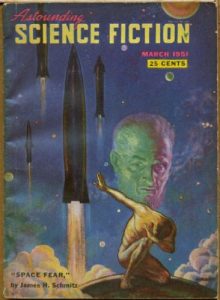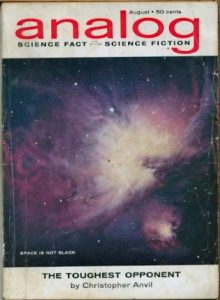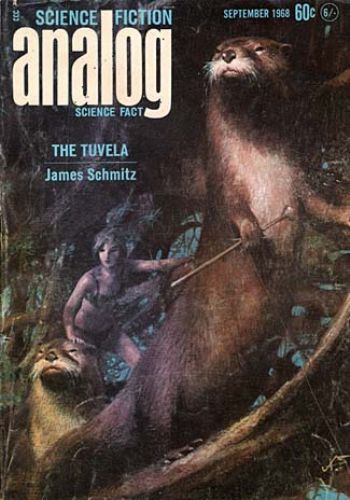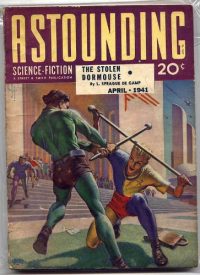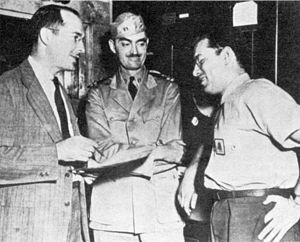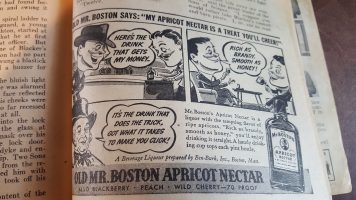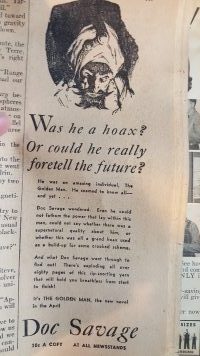Greetings all. This week I’m reviewing the Analog of July 1962. The cover story in this is John Brunner’s Listen! The Stars! and I love the cover art designed for it. It includes a good essay by John W. Campbell and a work by James H. Schmitz. Side note, I’ve already reviewed the issue immediately after this one. You can find that review here: https://robhowell.org/blog/?p=1579. This will be especially relevant since Mack Reynolds had a two-part story, with part one in this one and the second over there.
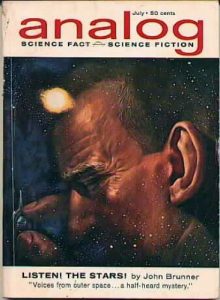
Table of Contents: http://www.isfdb.org/cgi-bin/pl.cgi?56754
The first article in this episode is What’s Wrong With Science by John W. Campbell. This is a distressing article, as it details things that are currently wrong in the scientific process, which means those problems are at least nearly sixty years in the making. Basically, he says that scientists are hamstrung by the process, which forces them to come up with answers that often fit the existing models that most scientists accept. Given that new research often radically changes or even replaces existing models, this means that such new research isn’t even allowed to be tried, because if it succeeds, it means that all the previous investment was wrong. Now, it’s as if instead of religious reactionaries wanting to execute Galileo, established scientists would execute him.
Sadly, I fear that this problem is even worse now, given examples I have seen.
The cover story Listen! The Stars! by John Brunner was fantastic. We discover a gadget that lets us listen to electromagnetic energy from other stars. In general these noises are not intelligible but there’s enough of a hint of something more, like hearing alien languages, that people keep listening. They’re hoping that they can understand that half-heard word they’re so tantalizingly close to comprehending.
This causes a number of societal issues, because that hope acts much like a drug. Addicts and acolytes, thieves and thespians. Worse, however, are the unexplained disappearances that seemed to be caused by “stardropping,” or eavesdropping on stars.
Dan Cross is a member of the UN Special Agency tasked to discover threats to peace. Basically, they’re trying to prevent the US and Russia from tossing their nukes at each other. The stardropping craze has finally come to their attention and he’s delving through the possibilities.
However, he and his agency are too late. Others have actually comprehended the science within what they find stardropping, science based essentially Einstein’s spooky action at a distance idea. This leads to both teleportation and telekinesis.
In the end, those who have discovered the potential from stardropping have generally unified together across the world. When the crisis happens, they reveal themselves with the intent to start the very war that Cross is tasked to protect. However, with their use of teleportation and telekinesis, they are easily able to distribute the atoms and particles of all the nuclear warheads and biological/chemical agents into the vastnesses of interstellar space.
The hint is that this will free humanity from its parochial differences and chase the stars, which are now within reach from their teleportative abilities.
It’s idealistic message fiction, promising a utopia that seems impossible for humanity. However, it’s also a fantastic story, filled with action and suspense. It’s also got enough hard science that it seems plausible.
Next is their announcement of things to come in the next issue. I won’t relate it here, but instead give you that link to my review again: https://robhowell.org/blog/?p=1579.
Then comes a single page on a scientific discussion of laser development by GE. As is often the case reading these magazines, it’s fascinating to read these sort of discussions. They provide a snapshot, in this case, of the development of lasers 57 years ago. I suspect anyone actually in the field, would find it very interesting.
Next is Junior Achievement by William Lee. I can’t find much about him. It is entirely possible that’s a pseudonym. One of his stories, A Message for Charity, was well-received. It has been republished a number of time and was turned into a Twilight Zone episode. However, very little else was published under this name.
Which is too bad. I rather enjoyed Junior Achievement, especially since at one time I was heavily involved in the organization. However, I didn’t have five geniuses to work with. In this case, they all come up with some new invention and the local science teacher, who is smart but not a genius, cannot quite keep up with them.
The only problem with this story is that it was more a narrative than a story. There wasn’t much of a buildup. No real crisis/climax. Instead, it went off at a rollicking pace of the kids involved making things happen and always succeeding. It was set in a town that had needed to be moved after some unexplained nuclear accident, so there’s some hint of genetic mutation, but not much, and that aspect only seems to be in the story to explain why the teacher is so poor. He has to pay two mortgages, one for the old house that’s in the fallout zone, and one for the new house. It’s an enjoyable story, but leaves you wanting more, like an ephemeral treat.
Now we get to James H. Schmitz, who I’ve grown to like much more because of the stories of his I’ve read doing these reviews. The story here is The Other Likeness, which is part of his series The Hub.
I was not disappointed. It starts with a scientist getting an alert. Then we discover he’s not just a scientist, but a member of a secret plot against humanity’s Federation involving 1200 people. These people are, in fact, aliens who were experts in genetics. They genetically raised these 1200 to be indistinguishable from humans. That would allow them to come into the Federation and create a bio-weapon that would devastate it, allowing their alien species to take over.
The scientist escapes with his three closest allies. At least, they think they escape. However, the Federation has set an elaborate trap for these 1200. They know them all because those 1200 have only 3 brain wave patterns, and are thus identified. Once captured, the 1200 are subjected to detailed scrutiny, most while they’re unconscious.
At this point, I was disappointed in the story. The initial start, with its evasion and capture, was really good, but immediately after that comes a disembodied voice explaining the plot. A series of exposition that would do Hercule Poirot proud, but in the context of a short story, takes too long.
But every once in a while, exposition can be the story, and this is the case here. Schmitz set us up to create espionage feel fighting the evil government bad guy, but the exposition reveals the truth at the very end.
The alien species was too successful. The beings it genetically created to be humans, were, in fact, human. None of the 1200 are actually going through with the bioweapon plan, instead doing something else that actually benefits humanity. The final line, which is spoken by the supposed government bad guy is fantastic: “You’ve regarded yourselves as human beings, and believed that your place among us. And we can only agree.”
It’s interesting how a really good writer can make something that shouldn’t work actually do so.
Next is an article that Dr. Robb Hampson should read, because I’ve no doubt he’d find it interesting. It’s Brain Waves and Though Patterns by Eric Holmes, MD. Holmes wrote a number of SF/F works, including the novel The Maze of Peril, but also contributed a number of essays on brain science.
This is one of his essays about understanding the brain. There’s a lot in here that I don’t know enough to appreciate. It does talk about some of the imagined possibilities, which are not dissimilar to ideas talked about today. It’s fascinating in it’s own right that 57 years ago people were talking about implanted electrodes to increase communication between brains, tracking health status, and so on. Basically, he’s talking about implants here which even then promised “unexpected marvels and possible horrors.”
I actually skipped the next story Border, Breed Nor Birth by Mack Reynolds. I tried to read it, but I have already read Part II of this story. Worse, I really didn’t like the way the story ends. Again, you can find that in the review here: https://robhowell.org/blog/?p=1579. It’s hard to connect with characters when you already know your not going to like the story, especially the ending. It was like watching a horror movie, knowing the kids are all going to do stupid stuff that makes it more likely the slasher’s going to get them. I don’t like watching them, either.
Anyway, I’m going to move on to the Analytical Library. I find this fascinating as it’s an attempt to objectively quantify what the readers want. It’s essentially much like a modern Amazon/Goodreads rating system. There’s also a bonus attached of an extra cent per word to the winning author, and that’s nothing to sneeze at.
What I learned in this version of the Analytical Library is that I really need to read the March, 1962 issue. Poul Anderson’s Epilogue beat Randall Garrett’s His Master’s Voice. I really like His Master’s Voice, so it’ll be fun to see the first version, but it’ll also be fun to read a story the readers thought was better.
And when I review that issue, I’ll talk about a number of interesting side notes involving Garrett and Anderson.
Anyway, next is The Rescuer by Arthur Porges. Porges was a prolific writer and a mathematician. i suspect my dad, who was a prolific reader and a mathematician, loved his stuff. I know I really liked this one. It’s very short, but also very powerful.
The story starts with a description of the greatest machine ever made, requiring multiple city blocks of space, fusion power, and computer power which might seem laughable now, but which was incredible then.
Then two scientists destroy it.
The story then turns to the preliminary hearing discussing the events that led to the destruction. In this, one of the scientists who destroyed the machine explained himself.
The machine was a time machine and one of the technicians involved in it commandeered the machine for his own purposes. However, he left a note, and the scientists, upon reading that note, decided that it was best to destroy the machine safely than allow the technician to succeed.
And this is where it gets thought-provoking. We’ve all wondered about changing the currents of time, but what if it changed so much more?
The technician is going back in time with a modern weapon and ammunition to prevent Jesus Christ’s crucifixion and execution. If Jesus had to die to save humans from their sins and that doesn’t happen, what next? Basically, it asks the question of all of us: Would you save Jesus of Nazareth? What would that do to all of history and to our souls? What a fascinating philosophical question and, as mentioned in the story, the kind of question we all have to answer for ourselves.
The last section, as usual in Analogs, is P. Schuyler Miller’s review section entitled The Reference Library. In this issue, he begins with a scathing discussion of the double-standard applied by publishing companies with respect to writers of SF and “literary” writers who happen to write an SF novel.
He nails something I talk about quite often at conventions. If you’re going to write in another genre you have to have read enough of the genre to understand the existing tropes and methods. In this case, the books in question didn’t get the hard science right, not even close to right. You also have to respect the genre, even if you’re writing a parody of it. Perhaps especially a parody, because if you despise it, your story comes out mean-spirited instead of humorous.
Anyway, Schuyler moves on to some more fun reviews. Imagine getting paid to review H. Beam Piper, Keith Laumer, Andre Norton, and a bunch of others. I’d take that job in a heartbeat.
I have to say, this was a darn good issue. It rises in my mind because I didn’t actually read through the Reynolds story, of course, but there’s quite a bit here I’m pleased to have read.
Next week, I’ll read the Fantastic Universe from July, 1957. It has works by August Derleth, Manly Wade Wellman, and Robert Sheckley. Wellman is a familiar name to me not simply because of his speculative fiction, by the way, which I’ll explain next week.
Next Week’s Issue: http://www.isfdb.org/cgi-bin/pl.cgi?89841
Thanks for reading. I’m off to finish a short story for James L. Young.
If you have any comments or would like to request I keep my eyes open for a specific issue or month, feel free to comment here or send an email to me at: rob@robhowell.org.
If you want to see previous reviews, the Mag Review category is here: https://robhowell.org/blog/?cat=432.
Have a great day.
Rob Howell
Author of the Shijuren-series of novels
- Website: www.robhowell.org
- Patreon: https://www.patreon.com/rhodri2112
- Blog: www.robhowell.org/blog
- Shijuren Wiki: http://www.shijuren.org/World+
of+Shijuren+Home - MeWe: https://mewe.com/i/rob.howell1
- Facebook Author Page: https://www.facebook.com/robho
well.org/ - Twitter: https://twitter.com/Rhodri2112

